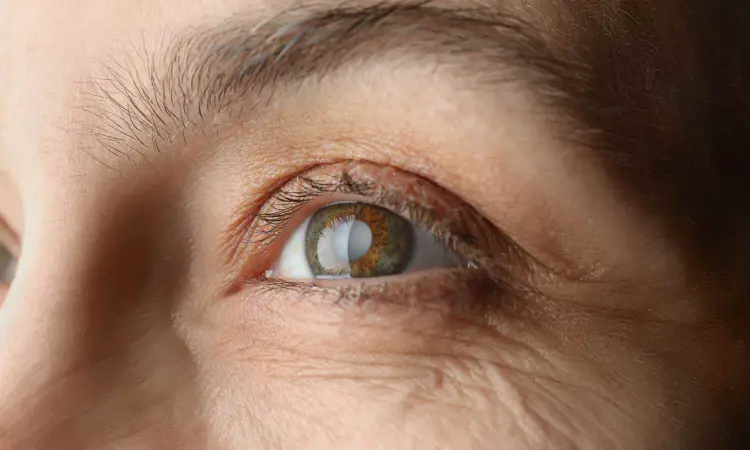- Home
- Medical news & Guidelines
- Anesthesiology
- Cardiology and CTVS
- Critical Care
- Dentistry
- Dermatology
- Diabetes and Endocrinology
- ENT
- Gastroenterology
- Medicine
- Nephrology
- Neurology
- Obstretics-Gynaecology
- Oncology
- Ophthalmology
- Orthopaedics
- Pediatrics-Neonatology
- Psychiatry
- Pulmonology
- Radiology
- Surgery
- Urology
- Laboratory Medicine
- Diet
- Nursing
- Paramedical
- Physiotherapy
- Health news
- Fact Check
- Bone Health Fact Check
- Brain Health Fact Check
- Cancer Related Fact Check
- Child Care Fact Check
- Dental and oral health fact check
- Diabetes and metabolic health fact check
- Diet and Nutrition Fact Check
- Eye and ENT Care Fact Check
- Fitness fact check
- Gut health fact check
- Heart health fact check
- Kidney health fact check
- Medical education fact check
- Men's health fact check
- Respiratory fact check
- Skin and hair care fact check
- Vaccine and Immunization fact check
- Women's health fact check
- AYUSH
- State News
- Andaman and Nicobar Islands
- Andhra Pradesh
- Arunachal Pradesh
- Assam
- Bihar
- Chandigarh
- Chattisgarh
- Dadra and Nagar Haveli
- Daman and Diu
- Delhi
- Goa
- Gujarat
- Haryana
- Himachal Pradesh
- Jammu & Kashmir
- Jharkhand
- Karnataka
- Kerala
- Ladakh
- Lakshadweep
- Madhya Pradesh
- Maharashtra
- Manipur
- Meghalaya
- Mizoram
- Nagaland
- Odisha
- Puducherry
- Punjab
- Rajasthan
- Sikkim
- Tamil Nadu
- Telangana
- Tripura
- Uttar Pradesh
- Uttrakhand
- West Bengal
- Medical Education
- Industry
Long-term Steroid Use for Vernal Keratoconjunctivitis Increases Glaucoma Risk: Study

Researchers have found in a new study that the risk of steroid-induced glaucoma increases with steroid use longer than 6 months, higher-potency formulations, and urban living, while even low-potency steroids were associated with ocular hypertension and glaucoma. The study was published in Cureus Journal of Medical Science by Suneeta D. and colleagues.
Vernal keratoconjunctivitis (VKC) is an autoimmune allergic eye condition requiring long-term steroid treatment for symptom control. Although steroids work, unmonitored or prolonged use risks complications such as steroid-induced ocular hypertension (SIOHT) and steroid-induced glaucoma (SIG) leading to irreversible blindness.
Risk factors and clinical distinctions between patient groups must be understood for early detection, proper management, and prevention of blindness. The present multicentric research investigated steroid-related and non-steroid-related factors of glaucoma in patients with VKC, as well as urban–rural differences in presentation and outcomes.
This was a retrospective review of the charts over four centers from April 2019 to March 2020. There were 2,360 patients with VKC included, and their records were reviewed for the use of steroids, clinical features, family history, allergy, refractive errors, and treatment outcomes. Patients were also stratified between urban and rural locations to analyze demographic parameters.
Results
• Among 2,360 VKC patients, SIOHT and/or SIG developed at 4.7%. Within them, the incidence of SIG was 53.5% and that of SIOHT was 46.5%, presenting at mean ages of 17.1 ± 5.9 years and 16.4 ± 6.0 years, respectively.
• Topical dexamethasone was used most commonly (50%) among them.
• Urban regions had greater prevalence of limbal VKC (23%) compared to rural regions (7.9%) (p = 0.01).
• 29 rural and 11 city patients were found to have a history of allergy, though the difference was not statistically significant (p = 0.1).
• Steroid use patterns also differed, with more intense usage among urban populations.
• Steroid withdrawal was adequate in 10.3% of the affected eyes,
• 62.9% needed anti-glaucoma drugs, and
• 24.9% needed surgery.
• Refractive errors also presented, with myopia in 26.5% of SIG/SIOHT eyes and hyperopia in 2.8%.
This multicentric research demonstrates that glaucoma is a significant vision-threatening complication in VKC, and 25% of involved patients need surgery. Urban patients, especially with limbal VKC, seem to be more susceptible, perhaps as a result of environmental exposures. These observations necessitate greater precautions in VKC management, more strict monitoring of steroid treatment, and specialized strategies in urban vs rural populations.
Reference:
Dubey S, Shakya R, Pegu J, et al. (August 13, 2025) Risk Factors Associated With Steroid-Induced Ocular Hypertension and Glaucoma in Patients With Vernal Keratoconjunctivitis in a North Indian Population: A Multicenter Study. Cureus 17(8): e89972. doi:10.7759/cureus.89972
Dr Riya Dave has completed dentistry from Gujarat University in 2022. She is a dentist and accomplished medical and scientific writer known for her commitment to bridging the gap between clinical expertise and accessible healthcare information. She has been actively involved in writing blogs related to health and wellness.
Dr Kamal Kant Kohli-MBBS, DTCD- a chest specialist with more than 30 years of practice and a flair for writing clinical articles, Dr Kamal Kant Kohli joined Medical Dialogues as a Chief Editor of Medical News. Besides writing articles, as an editor, he proofreads and verifies all the medical content published on Medical Dialogues including those coming from journals, studies,medical conferences,guidelines etc. Email: drkohli@medicaldialogues.in. Contact no. 011-43720751


